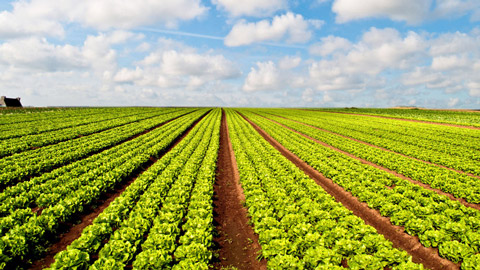Gladstone Land Benefitting from Demand for Organic Produce

According to Gladstone Land Corp. (NASDAQ: LAND), the expanding organic produce section in your local supermarket is a positive sign for the farmland REIT’s long-term health.
The company expects increased consumer demand for organic fruits and vegetables will continue to bolster the value of farmland in its portfolio for the next decade and beyond. Currently, more than 35 percent of the company’s fresh produce acreage is either organic or in transition to become organic.
“The high-value side of farmland is going to continue to have tremendous appreciation,” says David Gladstone, founder, president and CEO of Gladstone Land, in an interview with REIT.com.
Organics “Going Gangbusters”
Gladstone Land, the country’s first publicly traded farmland REIT, leases land to farmers on a triple-net basis. It owns 59 farms located in California, Oregon, Arizona, Colorado, Michigan, Nebraska and Florida. All farms are 100 percent leased. The company concentrates on acreage with on-site water sources that can support fresh produce and annual row crops, as well as permanent crops such as almonds, blueberries and pistachios.
“Organics are going gangbusters,” Gladstone says. Many of Gladstone Land’s tenant farmers want to convert their farms over to organic, “which we’re delighted to do,” he adds. The process of conversion takes three years to complete. Crop yields during that time are lower because no fertilizers can be used, but Gladstone says that hasn’t deterred farmers from making the switch.
In addition to converting existing farmland, Gladstone Land has also been actively purchasing properties already concentrating on organic crops.
Last year, the REIT paid approximately $26 million to purchase farmland in Colorado specializing in organic potatoes. In January, the company spent $54 million on approximately 3,750 acres of organic farmland in southern Florida, the largest acquisition in the company’s history.
“We see Gladstone Land’s external growth potential looking more attractive than ever, particularly if its increased scale can result in higher investment spreads and more chunky transactions going forward,” says John Massocca, analyst at Ladenburg Thalmann & Co., Inc.
He adds that on average, rent increases on lease renewals during the last four years have exceeded 17 percent. That indicates the company’s portfolio still possesses inherent rent growth potential, according to Massocca.
Scarcity of Land
At the same time that demand for high-value crops is thriving, the land where they are grown is becoming scarcer.
For example, about 100,000 acres are going out of production on an annual basis in California, according to Gladstone. Gladstone Land cites data showing that the value of irrigated cropland in California has increased 119 percent in the past 15 years. Prime coastal cropland, mainly used to grow crops such as strawberries, has appreciated 83 percent since 2000, according to the company. Most of Gladstone Land’s farms in California are located along the coast.
Moving Away from the Family Farm
As it pursues new acreage, Gladstone Land’s transactions are often carried out on a personal level.
“Every time we buy a farm that’s been owned for several generations, it’s like tearing their heart out,” Gladstone says. On the other hand, he adds, once the children and grandchildren of farming families are exposed to non-farming careers, many of them are reluctant to stay on the land. The significant tax consequences of passing a family farm from one generation to the next can also make farmers more willing to sell.
The company’s target purchase price for a farm is typically in a range of up to $50 million. Gladstone explains that the REIT can offer prospective sellers either cash or a tax-deferred exchange of shares in the company. Since its initial public offering in 2013, the REIT has purchased more than $350 million of new farm assets.
“There are going to be great opportunities for us. We have money, and people want to sell. Owning the dirt is a strong place to be for the next 10, 15 years,” Gladstone says.
Published at Tue, 28 Mar 2017 12:36:15 +0000


